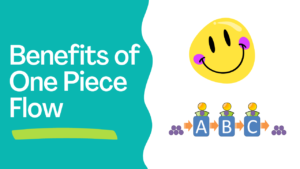Kanban is a Japanese word that means “signboard” or “Visual Card”.The Kanban method is a system for managing work that was created by Toyota Motor Corporation in the 1940s.
It is based on the idea of Just-in-Time production, which means producing only what is needed when it is needed.
The Kanban method has been used by Toyota to manage its production process, and it has been shown to be very effective in reducing waste and improving productivity.
In this article, we will discuss what the Kanban method is and how you can use it to improve your own workflow!
Table of Contents
How Does Kanban Work?
The Kanban method is based on the principle of Just-in-Time production, which means that work is only started when it is needed. This allows for more efficient use of resources and eliminates Process waste.
Kanban also uses a pull system, which means that work is only started when there is the capacity to do it. This helps to avoid overloading the system and ensures that work is evenly distributed.
Pull System: A system in which customer demand activates the production of a service or product.
Finally, Kanban uses visual cues to help workers understand what needs to be done and when it needs to be done. This helps to improve communication and coordination between team members.

How Can I Use Kanban?
If you want to improve your workflow, the Kanban method is a great place to start. It can help you to eliminate waste and increase productivity.
To get started, you will need to create a Kanban board. This can be done using a whiteboard or an online tool like Trello.
Next, you will need to identify the tasks that need to be done and create cards for each task. These cards should be placed on the Kanban board in the order that they need to be completed.
As you complete each task, you can move the card to the “done” column. This will help you to track your progress and ensure that you are completing tasks in a timely manner.
Where do we use the Kanban system?
The kanban system is used by a variety of businesses to improve their workflow. It can be used in any industry, and it is a great way to eliminate waste and increase productivity.
It can help you to get more done in less time, and it is a great way to improve communication and coordination between team members.

What are the 6 rules of kanban?
1. The kanban board should be simple and easy to understand.
One of the key principles of kanban is that the kanban board should be simple and easy to understand. This helps to ensure that everyone on the team can easily see what needs to be done and when it needs to be done.
The kanban board should be organized in a way that makes sense to you and your team. You can use a whiteboard, an online kanban tool, or even sticky notes to create your kanban board.
You will need to identify the tasks that need to be done and create cards for each task. These cards should be placed on the kanban board in the order that they need to be completed. As you complete each task, you can move the card to the “done” column. This will help you to track your progress and ensure that you are completing tasks in a timely manner.
2. Tasks should be broken down into small, manageable chunks.
Create a card for the task “Write an article on what is kanban?” and place it at the top of the kanban board.
Next, create cards for the tasks “Research kanban,” “Write article intro,” and “Write body of article.” Place these cards below the card for “Write an article on what is kanban?”
As you complete each task, you can move the card to the “done” column. This will help you to track your progress and ensure that you are completing tasks in a timely manner.
By breaking down tasks into small, manageable chunks, you can improve your workflow and get more done in less time!
3. Work should be prioritized based on importance and urgency.
One of the key principles of kanban is that work should be prioritized based on importance and urgency. This helps to ensure that the most important tasks are completed first, and it helps to prevent tasks from becoming backlogged.
You can prioritize tasks by placing them in different columns on the kanban board. For example, you might have a column for “high priority” tasks, a column for “medium priority” tasks, and a column for “low priority” tasks.
You can also use kanban to prioritize tasks by assigning them to different people on the team. For example, you might assign the task of “Write an article on what is kanban?” to someone who is more experienced with kanban, and you might assign the task of “Write article intro” to someone who is less experienced.
By prioritizing tasks based on importance and urgency, you can improve your workflow and get more done in less time!
4. The kanban board should be constantly updated and reviewed.
This helps to ensure that everyone on the team is always aware of what needs to be done and when it needs to be done. It also helps to prevent tasks from becoming backlogged.
You should update the kanban board regularly, and you should review it with your team members on a regular basis. This will help to ensure that everyone is on the same page and that tasks are being completed in a timely manner.
5. The kanban board should be used to track progress and ensure that tasks are completed in a timely manner.
6. The kanban board should be used to communicate with team members.
One of the key benefits of using Kanban is that it helps to improve communication between team members. This is because everyone on the team can see what needs to be done and when it needs to be done.
The kanban board can also be used to communicate with team members about specific tasks. For example, you might want to leave a note on the kanban board for the person who is assigned to write the article intro. This will help to ensure that everyone is on the same page and that tasks are being completed in a timely manner.
Kanban vs Scrum
- When it comes to kanban vs scrum, kanban is often seen as the simpler, less-structured approach. With kanban, there is less emphasis on tasks and deadlines, and more focus on continuous flow and improvement. This can be a benefit or a drawback, depending on your needs.
- Scrum is a more structured approach, with a clear focus on tasks, deadlines, and roles. This can make it more difficult to implement kanban in the scrum, but it can also be a benefit if you need more structure in your process.
Use of KANBAN in Manufacturing
In manufacturing Kanban card is used to track each task.
The kanban board has a number of columns that represent the different stages of work. As tasks are completed, they are moved to the next column.
The kanban system is flexible and can be adapted to any work process. It is also easy to use and understand, which makes it a popular choice for many organizations.
Types of kanban
There are several different types of kanban, each with its own benefits and drawbacks. The most common types are:
– Visual kanban
– Electronic kanban
– Lean Kanban
Visual kanban
Visual kanban is the most common type of kanban. It uses cards and a board to track tasks and visualize the flow of work. This can be a physical board or an online kanban tool.
The main advantage of visual Kanban is that it’s easy to use and understand. It’s also flexible, so it can be adapted to any work process. The main disadvantage is that it can be time-consuming to set up and maintain.
Electronic kanban
Electronic kanban is a digital version of visual kanban. It uses software to track tasks and visualize the flow of work. This can be a kanban tool or a project management software like Jira.
The main advantage of electronic kanban is that it’s easy to set up and maintain. It’s also more efficient than visual kanban since you can track and manage tasks online. The main disadvantage is that it can be expensive to set up and maintain.
Lean Kanban
Lean Kanban is a type of kanban that emphasizes continuous improvement. It uses the kanban system to track and improve the efficiency of workflows.
The main advantage of lean kanban is that it’s a flexible and efficient way to improve workflows. The main disadvantage is that it can be difficult to implement and maintain.
No matter which type of kanban you choose, the important thing is to find a system that works for you and your team.
Online Tools for following Kanban Approach
There are a number of kanban tools available, each with its own benefits and drawbacks. The most popular kanban tools are:
– Jira
– Trello
– Asana
Jira is a popular kanban tool that offers a wide range of features. The main advantage of Jira is that it’s easy to use and understand. The main disadvantage is that it can be expensive to set up and maintain.
Trello is a simple kanban tool that’s easy to use and understand. The main advantage of Trello is that it’s free to use. The main disadvantage is that it doesn’t offer as many features as Jira.
Asana is a kanban tool that’s designed for teams. The main advantage of Asana is that it offers a wide range of features and integrations. The main disadvantage is that it can be difficult to use and understand.
What are some of the benefits of kanban?
Some of the benefits of kanban include:
– improved communication
– better visibility into work progress
– more efficient use of resources
– reduced cycle times
– improved quality of work
What are the disadvantages of Kanban?
Some of the disadvantages of kanban include:
– kanban can be time-consuming to set up and maintain
– it can be difficult to implement and maintain
– kanban may not be suitable for all work processes
– kanban tools can be expensive to set up and maintain.




